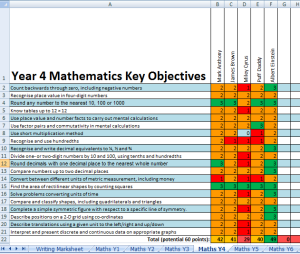The current government has made no secret of its intention to “raise standards” in the curriculum, and to expect higher attainment at the end of Key Stage 2. We have been told that the old Level 4 threshold was simply not demanding enough, and that from 2016 the new floor thresholds will be for 85% of children to reach the new higher standard.
Importantly, we were also told that the new higher standard would be broadly similar to a 4b under the current system. Now, setting aside the fact that 4b doesn’t really exist, this already meant – as Warwick Mansell pointed out in his excellent NAHT blog – that around 1/5th of schools would then fall below that threshold.
However, what has never been fully explained is how this new ‘level 4b equivalent’ will be arrived at. The floor standards will be based on the percentage of children attaining a scaled score of 100 or greater on the new tests. In theory this ought to represent attainment in line with expectations; that is, meeting the attainment targets set out in the curriculum. Only, of course, with the new attainment targets that simply means knowing/doing everything that’s set out in the Programme of Study.
In that case, it ought to be clear from the new Programmes of Study that the expectations are broadly in line with the old Level 4 attainment targets, with occasional increases to reflect the raising of the bar from ‘scraping a Level 4’ to achieving a secure Level 4.
Is it quite clear from a comparison of the old attainment targets and the new Programmes of Study that this is simply not the case. Below are three documents in which I’ve compared the three core subjects Programmes of Study against the old attainment targets in detail. In each case it is clear that the new Programmes of Study are significantly more demanding.
When I started to write these documents, I broke the old Level 4 attainment targets down into separate statements, and then drew comparisons. In fact, on reflection, I’d have been as well to take the level 5 statements, since the new Programmes of Study for Y6 are far more akin to the old Level 5 content. Take this highlighted example for Level 5 Number & Algebra:
I have highlighted those statements which match the new expected outcomes for Y6. In fact, the only statement which isn’t highlighted is about calculator use. Likewise, this Level 5 statement for Writing:
In fact, the Level 6 matches up to much of the new Y6 content:

It certainly seems unfair to argue that the new expectations are in line with Level 4b. There is clear evidence of a substantial rise in expectations at KS2 (for which, no doubt, the DfE would make no apology), but it certainly isn’t reasonable to state that it is a rise to the middle of the previously-expected band.
Of course, there is every possibility that the department will ensure that the thresholds for the new tests will be sufficiently low for them to be able to indicate equivalence to 4b by percentage terms – but that will do nothing to help schools with assessment and tracking towards end-of-key-stage outcomes. Yet another concern of the scoring system being completely unknown until after the tests are taken.
How many schools could reasonably expect 85% of their students to reach this new higher standard? If – as I suspect – the new standard is something closer to the current level 5, then how many schools are achieving anything close to this amount? Warwick Mansell found that around 1/5th of schools were failing to attaing the 85% L4b+ standard. By my estimates from the most recent performance tables exactly 6 schools had 85% or more of pupils achieving L5+ in all three subjects. Even by reducing the requirements to 75% achieving L5+ only 13 schools meet the grade.
Something here has got to give. Either the floor standard, or the way in which attainment is judged will need to be lowered if the floor threshold of 85% achieving 100+ is mean anything.
There are still many unanswered questions!







